Open access Unraveling ancestry, kinship, and violence in a Late Neolithic mass grave, by Schroeder et al. PNAS (2019).
Interesting excerpts of the paper and supplementary materials, about the Złota group variant of Globular Amphora (emphasis mine):
A special case is the so-called Złota group, which emerged around 2,900 BCE in the northern part of the Małopolska Upland and existed until 2,600-2,500 BCE. Originally defined as a separate archaeological “culture” (15), this group is mainly defined by the rather local introduction of a distinct form of burial in the area mentioned. Distinct Złota settlements have not yet been identified. Nonetheless, because of the character of its burial practices and material culture, which both retain many elements of the GAC and yet point forward to the Corded Ware tradition, and because of its geographical location, the Złota group has attracted significant archaeological attention (15, 16).
The Złota group buried their dead in a new, distinct type of funerary structure; so-called niche graves (also called catacomb graves). These structures featured an entrance shaft or pit and, below that, a more or less extensive niche, sometimes connected to the entrance area by a narrow corridor. Local limestone was used to seal off the entrance shaft and to pave the floor of the niche, on which the dead were usually placed along with grave goods. This specific and relatively sophisticated form of burial probably reflects contacts between the northern Małopolska Upland and the steppe and forest-steppe communities further to the east, who also buried their dead in a form of catacomb graves. Individual cases of the use of ochre and of deformation of skulls in Złota burials provide further indications of such a connection (15). At the same time, the Złota niche grave practice also retains central elements of the GAC funerary tradition, such as the frequent practice of multiple burials in one grave, often entailing redeposition and violation of the anatomical order of corpses, and thus differs from the catacomb grave customs found on the steppes which are strongly dominated by single graves. Nonetheless, at Złota group cemeteries single burial graves appear, and even in multiple burial graves the identity of each individual is increasingly emphasized, e.g. by careful deposition of the body and through the personal nature of grave goods (16).
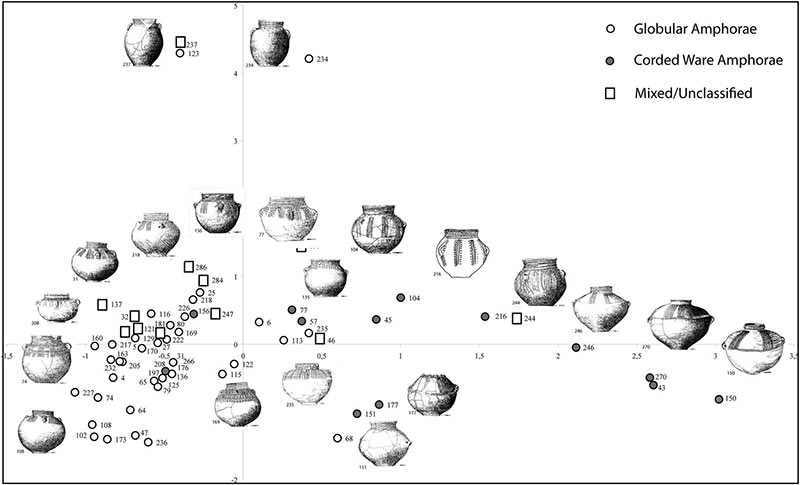
Just like its burial practices, the material culture and grave goods of the Złota group combine elements of the GAC, such as amber ornaments and central parts of the ceramic inventory, with elements also found in the Corded Ware tradition, such as copper ornaments, stone shaft-hole axes, bone and shell ornaments, and other stylistic features of the ceramic inventory. In particular, Złota group ceramic styles have been seen as a clear transitional phenomenon between classical GAC styles and the subsequent Corded Ware ceramics, probably playing a key role in the development of the typical cord decoration patterns that came to define the latter (17).
As briefly summarized above, the Złota group displays a distinct funerary tradition and combination of material culture traits, which give the clear impression of a cultural “transitional situation”. While the group also appears to have had long-distance contacts directed elsewhere (e.g. to Baden communities to the south), it is the combination of Globular Amphora traits, on the one hand, and traits found among late Yamnaya or Catacomb Grave groups to the east as well as the closely related Corded Ware groups that emerged around 2,800 BCE, on the other hand, that is such a striking feature of the Złota group and which makes it interesting when attempting to understand cultural and demographic dynamics in Central and Eastern Europe during the early 3rd millennium BCE.

Książnice (site 2, grave 3ZC), Świętokrzyskie province. This burial, a so-called niche grave of the Złota type (with a vertical entrance shaft and perpendicularly situated niche), was excavated in 2006 and contained the remains of 8 individuals, osteologically identified as three adult females and five children, positioned on limestone pavement in the niche part of the grave. Radiocarbon dating of the human remains indicates that the grave dates to 2900-2630 BCE, 95.4% probability (Dataset S1). The grave had an oval entrance shaft with a diameter of 60 cm and depth of 130 cm; the depth of the niche reached to 170 cm (both measured from the modern surface), and it also contained a few animal bones, a few flint artefacts and four ceramic vessels typical of the Złota group. Książnice is located in the western part of the Małopolska Upland, which only has a few Złota group sites but a stronger presence of other, contemporary groups (including variants of the Baden culture).
Wilczyce (site 90, grave 10), Świętokrzyskie province. A rescue excavation in 2001 uncovered a niche grave of the Złota type, which had a round entrance shaft measuring 90 cm in diameter. The grave was some 60-65 cm deep below the modern surface and the bottom of the niche was paved with thin limestone plates, on which remains of three individuals had been placed; two adults, one female and one male, and one child. Four ceramic vessels of Złota group type were deposited in the niche along with the bodies. Wilczyce is located in the Sandomierz Upland, an area with substantial presence of both the Globular Amphora culture and Złota group, as well as the Corded Ware culture from 2800 BCE.
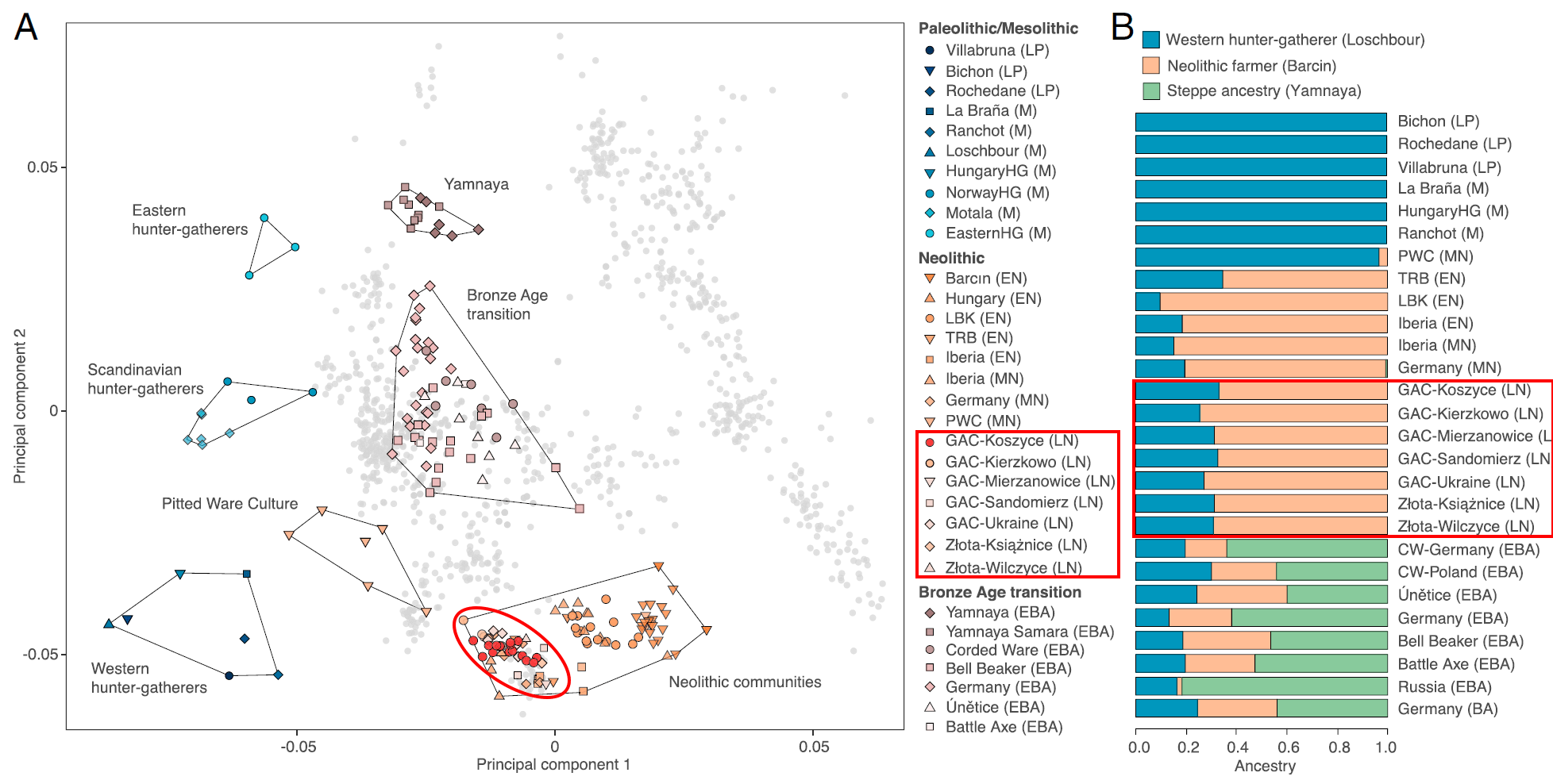
To further investigate the ancestry of the Globular Amphora individuals, we performed a supervised ADMIXTURE (6) analysis, specifying typical western European hunter-gatherers (Loschbour), early Neolithic Anatolian farmers (Barcın), and early Bronze Age steppe populations (Yamnaya) as ancestral source populations (Fig. 2B). The results indicate that the Globular Amphora/Złota group individuals harbor ca. 30% western hunter-gatherer and 70% Neolithic farmer ancestry, but lack steppe ancestry. To formally test different admixture models and estimate mixture proportions, we then used qpAdm (7) and find that the Polish Globular Amphora/Złota group individuals can be modeled as a mix of western European hunter-gatherer (17%) and Anatolian Neolithic farmer (83%) ancestry (SI Appendix, Table S2), mirroring the results of previous studies.
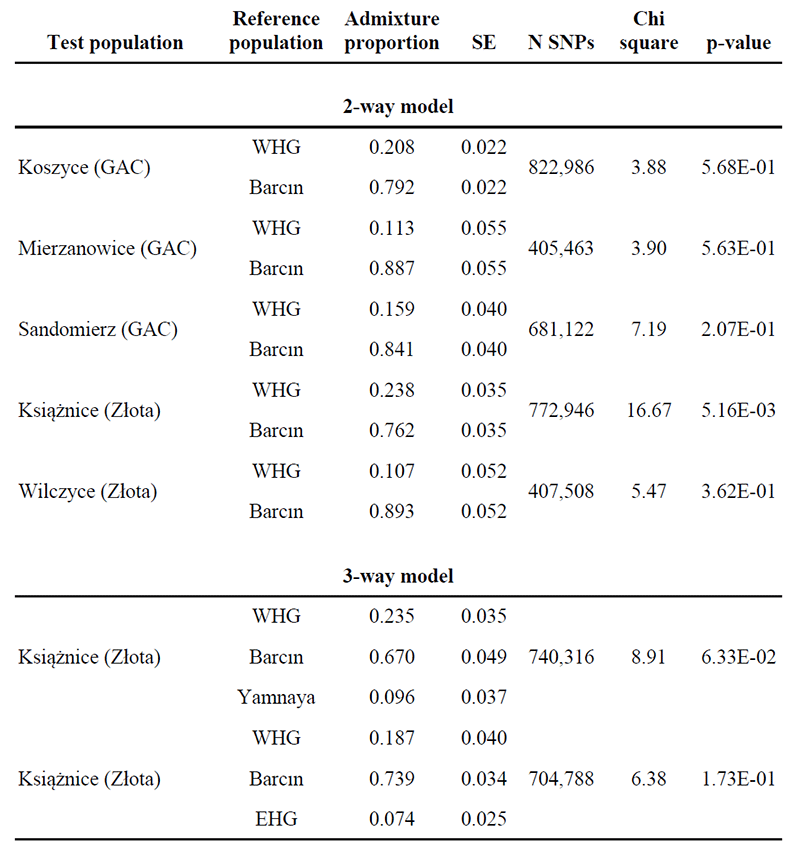
can be modelled as a two-way mixture of Mesolithic western hunter-gatherers (WHG), and early Anatolian Neolithic farmers (Barcın). The five individuals from Książnice (Złota group) show evidence for additional gene flow, most likely from an eastern source.
The lack of a direct genetic connection of Corded Ware peoples with the Złota group despite their common “steppe-like traits” – shared with Yamna – reveals, once more, how the few “Yamna-like” traits of Corded Ware do not support a direct connection with Indo-Europeans, and are the result of the expansion of the so-called steppe package all over Europe, and particularly among cultures closely related to the Khvalynsk expansion, and later under the influence of expanding Yamna peoples.
The results from Książnice may support that early Corded Ware peoples were in close contact with GAC peoples in Lesser Poland during the complex period of GAC-Trypillia-CWC interactions, and especially close to the Złota group at the beginning of the 3rd millennium BC. Nevertheless, patrilineal clans of Złota apparently correspond to Globular Amphorae populations, with the only male sample available yet being within haplogroup I2a-L801, prevalent in GAC.
NOTE. The ADMIXTURE of Złota samples in common with GAC samples (and in contrast with the shared Sredni Stog – Corded Ware “steppe ancestry”) makes the possibility of R1a-M417 popping up in the Złota group from now on highly unlikely. If it happened, that would complicate further the available picture of unusually diverse patrilineal clans found among Uralic speakers expanding with early Corded Ware groups, in contrast with the strict patrilineal and patrilocal culture of Indo-Europeans as found in Repin, Yamna and Bell Beakers.
Once again the traditional links between groups hypothesized by archaeologists – like Gimbutas and Kristiansen in this case – are wrong, as is the still fashionable trend in descriptive archaeology, of supporting 1) wide cultural relationships in spite of clear-cut inter-cultural differences (and intra-cultural uniformity kept over long distances by genetically-related groups), 2) peaceful interactions among groups based on few common traits, and 3) regional population continuities despite cultural change. These generalized ideas made some propose a steppe language shared between Pontic-Caspian groups, most of which have been proven to be radically different in culture and genetics.
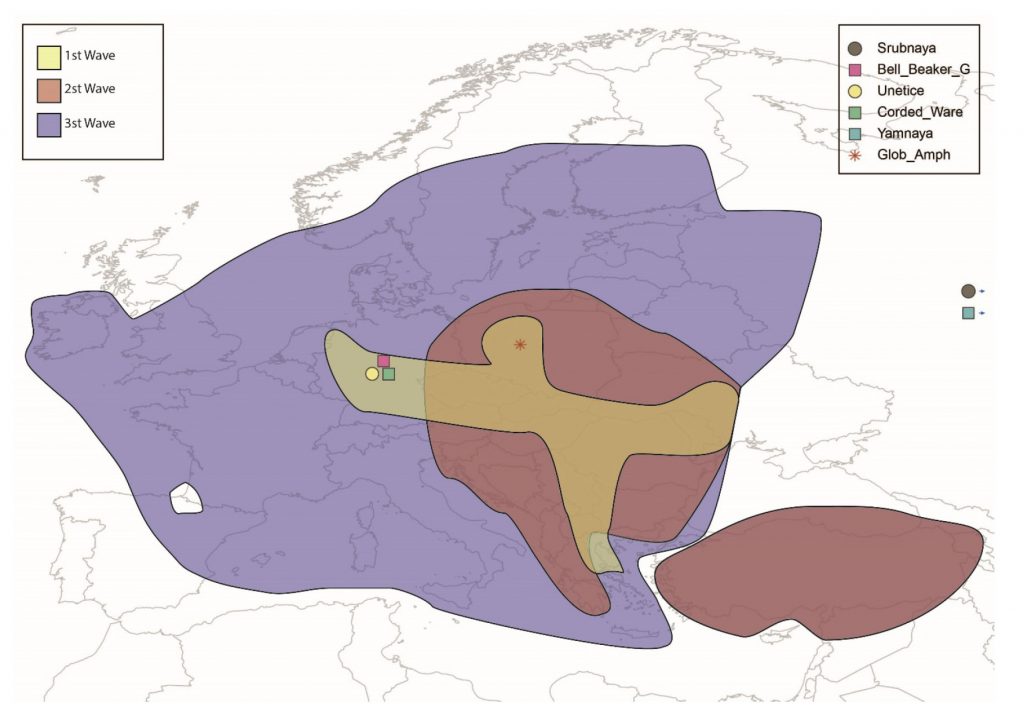
Furthermore, paternal lines show once again marked bottlenecks in expanding Neolithic cultures, supporting their relevance to follow the ethnolinguistic identity of different cultural groups. The steppe- or EHG-related ancestry (if it is in fact from early Corded Ware peoples) in Książnice was thus probably, as in the case of Trypillia, in the form of exogamy with females of neighbouring groups:
The presence of unrelated females and related males in the grave is interesting because it suggests that the community at Koszyce was organized along patrilineal lines of descent, adding to the mounting evidence that this was the dominant form of social organization among Late Neolithic communities in Central Europe. Usually, patrilineal forms of social organization go hand in hand with female exogamy (i.e., the practice of women marrying outside their social group). Indeed, several studies (11, 12) have shown that patrilocal residence patterns and female exogamy prevailed in several parts of Central Europe during the Late Neolithic. (…) the high diversity of mtDNA lineages, combined with the presence of only a single Y chromosome lineage, is certainly consistent with a patrilocal residence system.
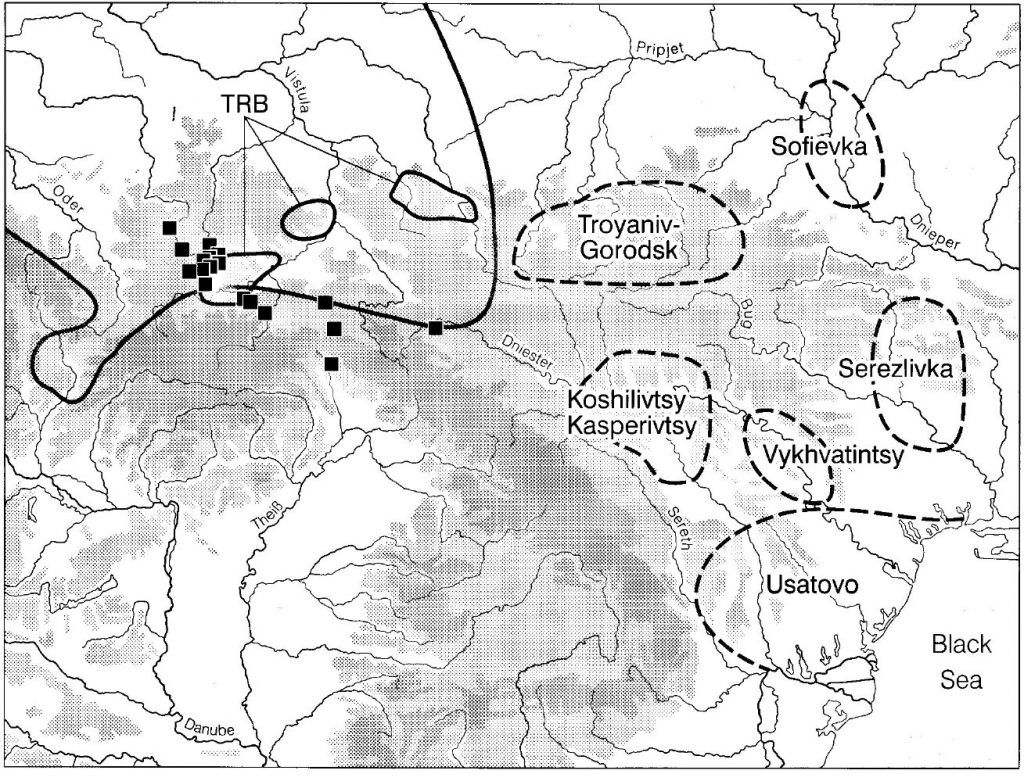
Since ancient and modern Uralians show predominantly Corded Ware ancestry, and Proto-Uralic must have been in close contact with Proto-Indo-European for a very long time – given the different layers of influence that can be distinguished between them -, it follows as logical consequence that the North Pontic forest-steppes (immediately to the west of the PIE homeland in the Don-Volga-Ural steppes) is the most likely candidate for the expansion of Proto-Uralic, accompanying the spread of Sredni Stog ancestry and a bottleneck under R1a-M417 lineages.
The early TMRCAs in the 4th millennium BC for R1a-M417 and R1a-Z645 support this interpretation, like the R1a-M417 sample found in Sredni Stog. On the other hand, the resurgence of typical GAC-like ancestry in late Corded Ware groups, with GAC lineages showing late TMRCAs in the 3rd millennium BC, proves the disintegration of Corded Ware all over Europe (except in Textile Ceramics- and Abashevo-related groups) as the culture lost its cohesion and different local patrilineal clans used the opportunity to seize power – similar to how eventually I2a-L621 infiltrated eastern (Finno-Ugrian) groups.
Related
- Uralic speakers formed clines of Corded Ware ancestry with WHG:ANE
- Sredni Stog, Proto-Corded Ware, and their “steppe admixture”
- Corded Ware culture origins: The Final Frontier
- Corded Ware—Uralic (I): Differences and similarities with Yamna
- Corded Ware—Uralic (II): Finno-Permic and the expansion of N-L392/Siberian ancestry
- Corded Ware—Uralic (IV): Hg R1a and N in Finno-Ugric and Samoyedic expansions
- Corded Ware—Uralic (III): “Siberian ancestry” and Ugric-Samoyedic expansions
- On the origin and spread of haplogroup R1a-Z645 from eastern Europe
- “Steppe ancestry” step by step: Khvalynsk, Sredni Stog, Repin, Yamna, Corded Ware
- Resurge of local populations in the final Corded Ware culture period from Poland
- Haplogroup R1a and CWC ancestry predominate in Fennic, Ugric, and Samoyedic groups